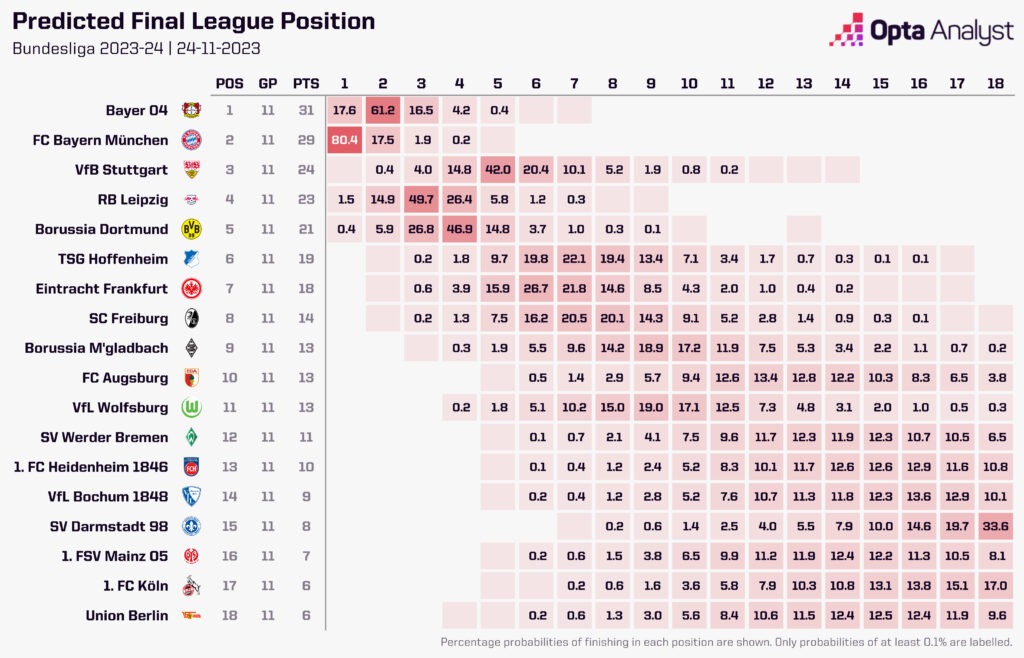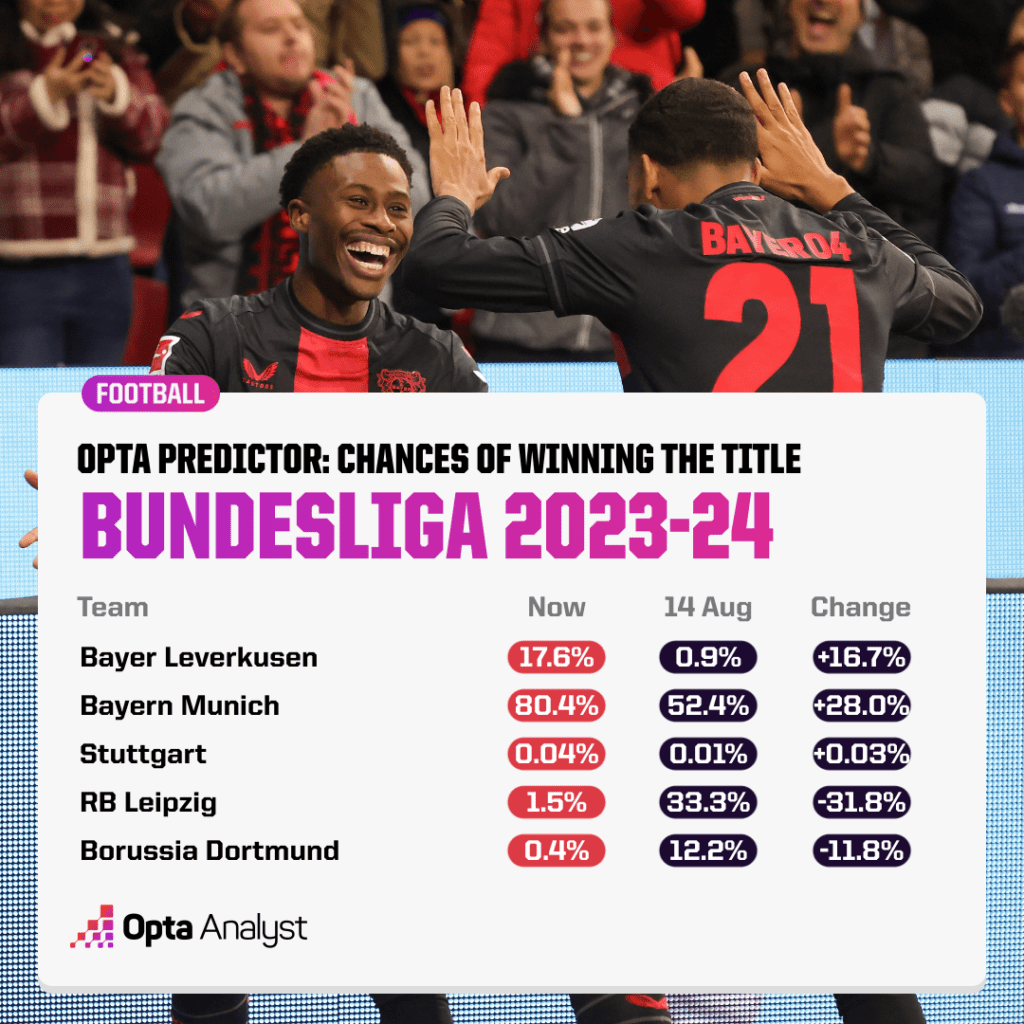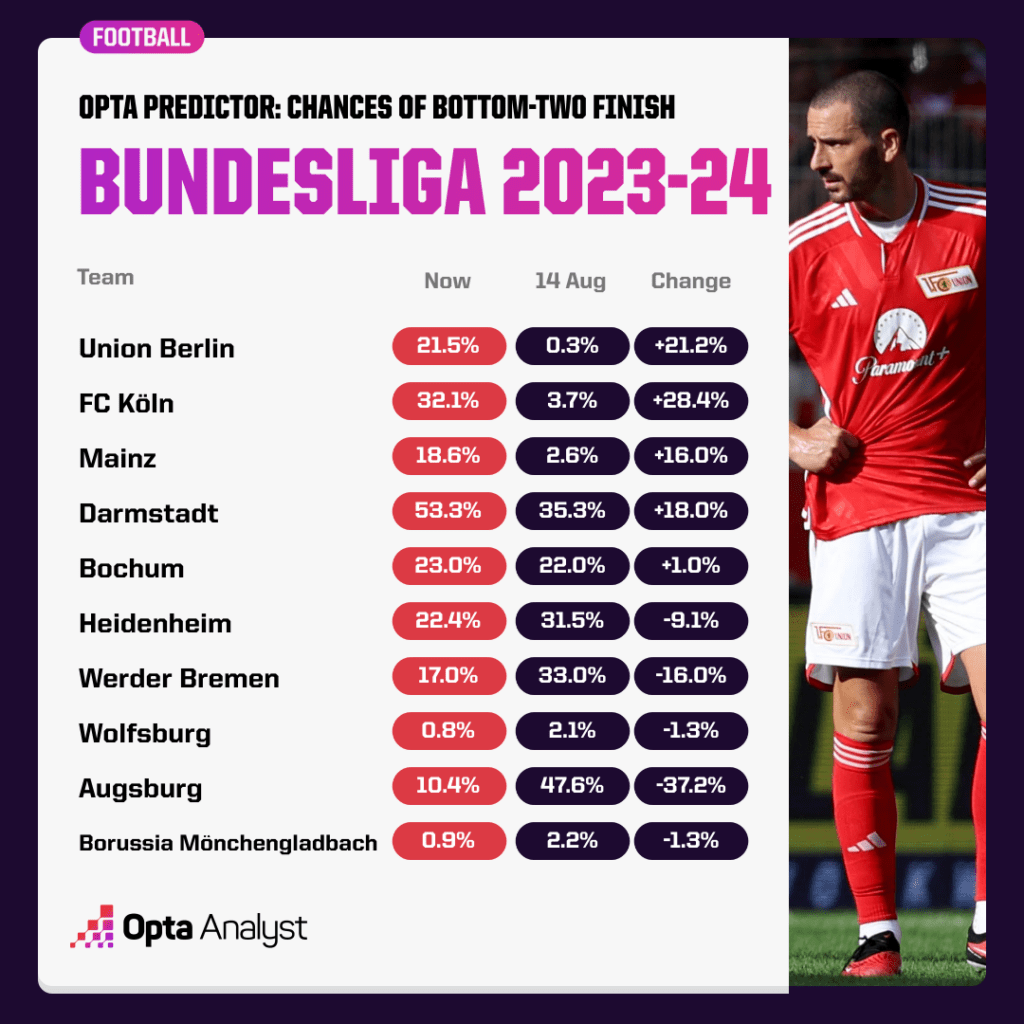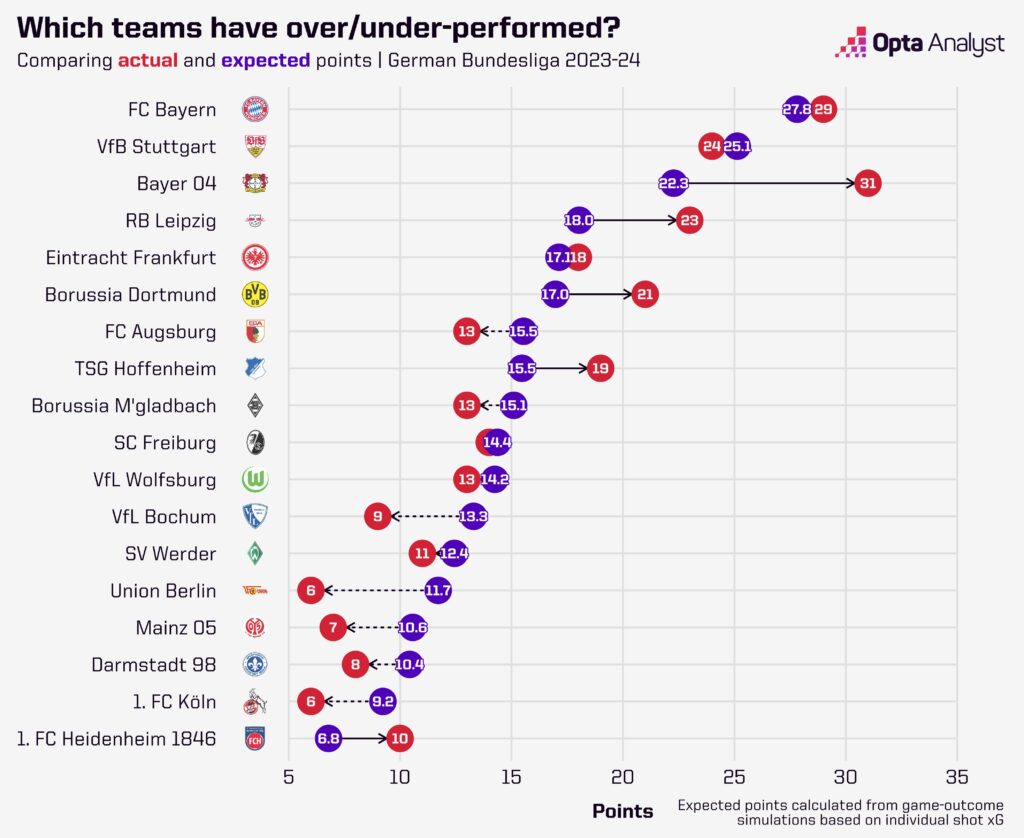With 11 games gone, we look at all the key questions in Germany with our Bundesliga 2023-24 season predictions via our trusty Opta supercomputer.
Bundesliga Season Predictions: The Quick Hits
Favourites for the Title: Bayern Munich
Top Four Favourites: Bayer Leverkusen, RB Leipzig, Borussia Dortmund
Relegation Favourites: FC Köln and SV Darmstadt
At the beginning of the season, we tasked the Opta supercomputer with simulating the 2023-24 Bundesliga campaign 10,000 times to see how it may pan out.
Unsurprisingly, Bayern Munich were the overwhelming favourites to make it 12 titles in a row. Bayer Leverkusen were backed to challenge them, though, and that’s exactly what has happened so far.
With 11 games gone and the Bundesliga about to return after the final international break of the year, we thought it was time to nudge the supercomputer again to see how those percentages predicting the title race, top-four tussle and relegation scrap have changed since the start of the season.
The table below provides a percentage that corresponds to how often in 10,000 season simulations each club finished in a given position, and after that you’ll find our analysis.

Who Will Win the Bundesliga in 2023-24?
It may seem slightly strange given they aren’t even top of the table heading into Matchday 12, but Bayern Munich’s chances of once again winning the Bundesliga title have gone up quite a bit since the season began. They won it 52.4% of the time in the Opta supercomputer’s 10,000 simulations in August, and that has now gone up to 80.4% of the time.
The seamless transition of Harry Kane from scoring goals in the Premier League to doing so in the Bundesliga has helped a lot, as have recent thrashings of Bochum (7-0), Borussia Dortmund (4-0) and Darmstadt (8-0).
They may have been knocked out of the DFB-Pokal by third-tier side Saarbrücken, but Thomas Tuchel’s men are looking unstoppable once again in the league, so far only being kept off top spot by a very impressive Bayer Leverkusen. Xabi Alonso has guided his team to the summit after 11 games, though the supercomputer still only gives them a 17.6% chance of converting their excellent start into a title.
Their 2-2 draw with Bayern in Munich is the only game in which they’ve dropped points this season, with the likes of Florian Wirtz and Victor Boniface in fine form so far. They host Dortmund in early December, the team that ran Bayern so close last season but ultimately fell just short on the last day.
Edin Terzić and his team have so far been unable to replicate the form of 2022-23, currently sitting in fifth place and 10 points off the top. They were given a pre-season probability of 12.2% of going one better and winning the title, but that has now shrunk to just 0.4%.
The surprise package of the season so far has been Stuttgart, who went into the international break in third spot. Thanks largely to the goals of Serhou Guirassy, Sebastian Hoeneß’s team find themselves sandwiched between Bayern and RB Leipzig inside the UEFA Champions League spots. A title win does still seem very unlikely though, with the supercomputer suggesting they only won it 0.04% of the time in its simulations.
Leipzig went into the campaign as second favourites behind Bayern, judged then to have a one-in-three chance (33.3%) of winning the title. After a few stumbles, notably drawing at home to Bochum and losing at Mainz, they sit in fourth place and their title chances have reduced to just 1.5%.
Outside of those five teams, no other has been given even a 0.01% chance of winning the Bundesliga this season.

Who Will Qualify for the Champions League?
While there is a four-in-five chance of Bayern again taking home the Meisterschale, the race for the Champions League spots is far more open.
Across the 10,000 simulations, Bayern Munich finished inside the top four in 99.9% of them. It would be quite fun to go and see the reaction in the 0.1% of simulations where they didn’t.
Neutrals will be hoping that Leverkusen make a title race of it as Dortmund did last season, but it would still be an impressive achievement for Alonso to just secure a top-four spot, which looks very likely at the moment with the supercomputer suggesting it as a 99.5% probability.
Things are nowhere near as certain for Stuttgart, though. After an excellent start to the season, which included winning seven of their first eight games (L1), two defeats in their last three (W1) coupled with their low odds at the start of the campaign mean the supercomputer has less faith in them securing a top-four finish. They do so in just 19.3% of simulations, with it judged that they have more chance of qualifying for the UEFA Europa League (42.0%) or the UEFA Europa Conference League (20.4%).
That will be of comfort to RB Leipzig, still estimated to have a strong 92.6% probability of qualifying for the Champions League again, while Dortmund are handed an 80.1% likelihood of doing so despite their wobbly start, including defeat last time out at Stuttgart.
As for the rest, only three teams are given a greater than 1% chance of placing in the top four. Eintracht Frankfurt (4.5%), Hoffenheim (2.1%) and Freiburg (1.4%) would probably all concede their hopes are somewhat optimistic even just a third of the way into the season.
Interestingly, despite seven Bundesliga teams already being written off as having a 0% chance of qualifying for the Champions League, bottom club Union Berlin apparently manage to pull off a miraculous recovery and actually finish in the top four in 0.01% of simulations. They couldn’t… could they?
Who Will Be Relegated from the Bundesliga in 2023-24?
The percentages here just look at who will finish in the bottom two. It does not take into account the chances of finishing in the relegation playoff spot.
Sticking with Union Berlin, few could have seen their fall from grace coming quite so quickly. Urs Fischer has left the club and they sit bottom of the league after 11 games, all while competing in their first-ever Champions League campaign.
That said, the supercomputer clearly still has a soft spot for them, and rates their chances of finishing in the bottom two at just 21.5%. Significantly up on the start of the season when their chances were just 0.3%, but still with a more than fighting chance of avoiding the drop after their impressive fourth-place finish last season.
However, look away now if you are a fan of Darmstadt. The newly-promoted club secured back-to-back wins against Werder Bremen and Augsburg in October that have seen them stay out of the automatic relegation spots, but aside from that, they have looked like a team that could struggle this season. They have lost seven of their 11 games so far (D2), including the aforementioned 8-0 thrashing at Bayern. That said, five of their seven defeats have come against teams in the top seven in the table, so perhaps their 53.3% likelihood of going straight back down is a little harsh.
That percentage makes Darmstadt big favourites for a bottom-two finish, with the next most likely team apparently second-bottom FC Köln (32.1%). That rise from their chances of just 3.7% in August may be due to a start to the season that saw Köln lose six of their first seven games (D1), though a win against Borussia Mönchengladbach and recent back-to-back draws with Augsburg and Bochum suggest perhaps a recovery is starting for Steffen Baumgart’s side. Hennes the goat will be pleased if so.
The favourites for relegation at the start of the season were Augsburg, but they sit in 10th place after picking up 13 points from 11 games, which has seen their chances go down from 47.6% to 10.4%. Still not out of the woods but positive for them nonetheless. The same could be said for plucky underdogs Heidenheim, who had a 31.5% chance of a bottom-two finish in August, but that has reduced to 22.4% after a decent start to Bundesliga life (10 points from 11 games).

Bochum have barely seen their chances change, up slightly to 23% from 22% at the start of the season, while Werder Bremen’s has reduced from 33% to 17%. The percentage has gone up for 16th-place Mainz, but perhaps not by as much as you’d think. The supercomputer is fairly confident they’ll stay out of trouble, giving them just an 18.6% likelihood of going down.
Outside of that, no other team has a greater than 1% chance of finishing in the bottom two.
Bochum are considered likeliest to finish in 16th place, which would mean they would take part in the relegation playoff.
Bundesliga Expected Points

Our expected points model simulates the number of goals scored by each side in each match based on the expected goals (xG) value of every shot taken. It then uses the simulated number of goals to determine the match outcome (win/draw/loss), with each game run through the model 10,000 times. The expected points for each team in every match can then be calculated based on the proportion of simulations they win/draw/lose. This is of course not an exact science, as xG data doesn’t include a lot of factors, such as game state and dangerous periods of possession that don’t lead to shots.
Perhaps it is no surprise to see Bayern top of the Bundesliga’s expected points table, with the suggestion that Tuchel’s side have only overperformed marginally. Bayer Leverkusen, on the other hand, have overperformed spectacularly, having won nine more points than they should have, in theory. A ruthlessness in front of goal will have primarily aided this, with Alonso’s men scoring 34 goals from just 23.9 xG.
That actually means Stuttgart should be a place higher than they are. They have one point fewer than expected, which is likely due to them having conceded 14 goals from an xG against of just 11.3. If they can level that out, perhaps we could have a three-horse title race after all.
Leipzig are where they’re expected to be, in fourth, though five points better off thanks to scoring 10 more goals (28) than their 18.2 xG, while Dortmund might be surprised to learn that their fifth place is still considered to be an overachievement at this stage. They have four more points than expected and should be sixth according to the model. Their xG against might be to blame here, with only five teams in the league conceding more than their 20.1, so BVB should have conceded even more than the 17 they have. Even two of the bottom three have lower xG against (Mainz – 15.9, Union Berlin – 16.7).
At the other end of the table, Union are unsurprisingly considered to be underachieving. They should have six more points than they do according to the model and be in 14th place rather than bottom. The team that should be bottom are also the division’s biggest overachievers, Heidenheim. They should have three points fewer, but should be five places lower. They are significantly outperforming compared to both their xG for and xG against, so presumably this is chiefly because of the quality of teams they have played so far.
Opta-Simulated Bundesliga 2023-24 Table
After simulating the remainder of the 2023-24 Bundesliga season 10,000 times, we’re able to average the points total of every club across those simulations and therefore rank teams positionally. Here are the Opta supercomputer results from those simulations:
1st: Bayern Munich
2nd: Bayer Leverkusen
3rd: RB Leipzig
4th: Borussia Dortmund
5th: Stuttgart
6th: Eintracht Frankfurt
7th: Hoffenheim
8th: Freiburg
9th: Wolfsburg
10th: Borussia Mönchengladbach
11th: Augsburg
12th: Werder Bremen
13th: Mainz
14th: Union Berlin
15th: Heidenheim
16th: Bochum
17th: FC Köln
18th: Darmstadt
How Does the Opta Supercomputer Model Work?
• Opta’s League Prediction model estimates the likelihood of teams finishing in each position in the competition. We can therefore see how successful a team’s season is likely to be, whether it’s their relegation or title chances.
• The model estimates the probability of each match outcome (win, draw or loss) by using betting market odds and Opta Power Rankings. The odds and rankings are based on historical and recent team performances.
• The model considers the strength of opponents by using these match outcome probabilities and simulates the remaining fixtures in the competition thousands of times. By analysing the outcome of each of these simulations, the model can see how often teams finished in each league position to create our final predictions.
Enjoy this? Subscribe to our mailing list to receive exclusive weekly content. And follow us on Twitter too.
